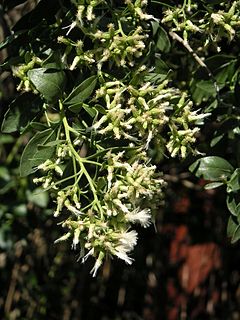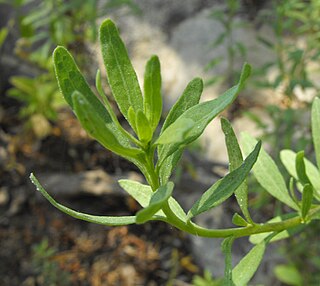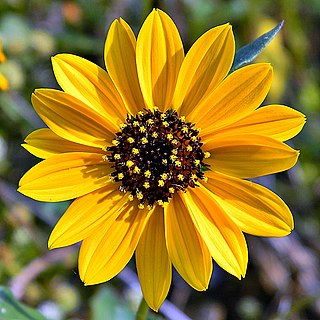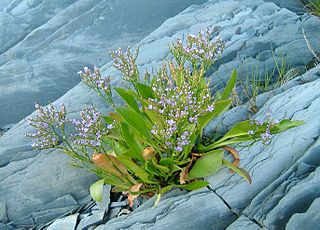
Iva annua, the annual marsh elder or sumpweed, is a North American herbaceous annual plant in the sunflower family that was historically cultivated by Native Americans for its edible seed.
Amaranthus floridanus, the Florida amaranth, is a flowering plant endemic to Florida.

The Anastasia Island beach mouse is a subspecies of the oldfield mouse of the southeastern United States. It occurs in the sand dunes of Florida and Alabama beaches. It has been classified by the United States Fish and Wildlife Service as an endangered species due to the specificity of its habitat and the natural and human-induced destruction thereof.

Iva is a genus of wind-pollinated plants in the daisy family, described as a genus by Linnaeus in 1753. Plants of this genus are known generally as marsh elders. The genus is native to North America.

Baccharis halimifolia is a North American species of shrubs in the daisy family. It is native to Nova Scotia, the eastern and southern United States, eastern Mexico, the Bahamas, and Cuba.

Iva hayesiana is a species of flowering plant in the daisy family known by the common names San Diego marsh-elder and San Diego povertyweed.

Solidago sempervirens, the seaside goldenrod or salt-marsh goldenrod, is a plant species in the genus Solidago of the family Asteraceae. It is native to eastern North America and parts of the Caribbean. It is an introduced species in the Great Lakes region and the Azores.

Iva frutescens is a species of flowering plant in the aster family known by the common names Jesuit's bark, bigleaf marsh-elder, and high-tide bush. It grows in coastal eastern North America from Nova Scotia down the eastern coast and along the Gulf Coast to Texas.

Cyclachaena xanthiifolia, known as giant sumpweed, or rag sumpweed is a North American plant species in the sunflower family, Asteraceae. It is the only species in the genus Cyclachaena. Giant sumpweed is believed to be native to the Great Plains but is now found across much of southern Canada and the contiguous United States, though rarely in the Southeast.

Helianthus debilis is a species of sunflower known by the common names cucumberleaf sunflower, beach sunflower, weak sunflower, and East Coast dune sunflower. It is native to the United States, where it can be found along the Atlantic and Gulf Coasts. It is known elsewhere as an introduced species, such as South Africa, Australia, Taiwan, Slovakia, and Cuba.
Juncus megacephalus, the bighead rush, is a plant species native to the United States. It is known from every seacoast state from Texas to Maryland, as well as Massachusetts, growing in freshwater marshes, sand dunes, and disturbed sites at elevations less than 100 m.

Bidens mitis, the smallfruit beggarticks, is a North American species of flowering plant in the daisy family. It is native to the eastern, southeastern, and south-central parts of the United States, from eastern Texas to southern New Jersey.
Chrysopsis godfreyi, is a North American species of flowering plant in the aster family. It is native to the states of Florida and Alabama in the southeastern United States.
Chrysopsis gossypina, called the Cottony goldenaster, is a North American species of flowering plant in the aster family. It is native to the Coastal Plain of the southeastern United States, from eastern Louisiana to southeastern Virginia.

Fleischmannia incarnata, the pink slender-thoroughwort or pink thoroughwort, is a North American species of flowering plant in the sunflower family. It is native to the United States from Florida north as far as Virginia, Ohio, and Illinois, and west to Texas and Oklahoma. It is also found in northeastern Mexico.
Iva angustifolia is a species of flowering plant in the daisy family known by the common name narrowleaf marsh elder. It grows in the south-central and southeastern United States.
Iva asperifolia, the Pensacola marsh elder, is a species of flowering plant in the daisy family. It grows in the south-central United States. It has also been found in the state of Veracruz in eastern Mexico.

Iva axillaris, called povertyweed or death weed, is a North American species of flowering plants in the daisy family. It grows in the western and central United States and in western Canada, from British Columbia south to California and east as far as the western Great Plains in the Texas Panhandle, Nebraska, the Dakotas, and Manitoba. It has also become established in Australia, where it is considered a weed.
Iva microcephala, the piedmont marsh elder, is a North American species of flowering plants in the daisy family. It grows in the southeastern United States in Alabama, Florida, Georgia, and the Carolinas.

Limonium carolinianum, known variously as Carolina sealavender, canker root, ink root, marsh root, lavender thrift, American thrift, or seaside thrift, is a species of flowering plant native to the eastern shores of North America, from northern Mexico to Canada. It is a slow-growing perennial herb found in salt marshes and other maritime habitats. Its inflorescences are frequently harvested for use in cut flower arrangements.












